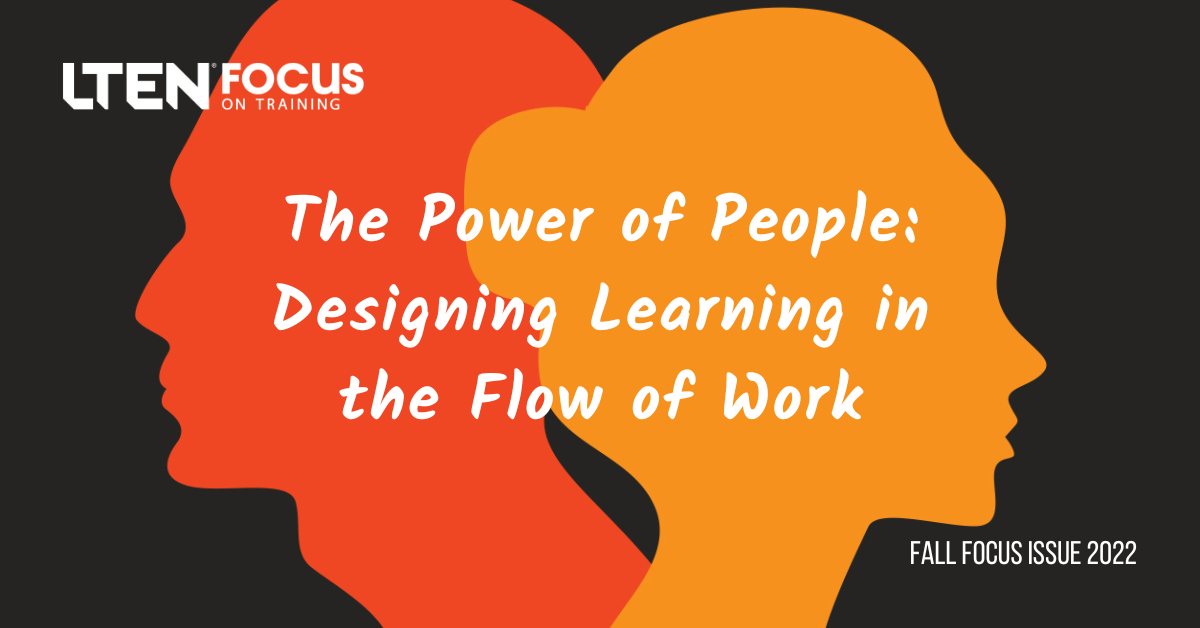
FEATURE STORY – By Hollace Masino
Creating opportunities for people to continually learn and grow
Chances are you’ve heard of learning in the flow of work. This method of training is rooted in the recognition that learning and development is happening all the time. As training professionals, we’re increasingly called on to incorporate learning in the flow of work strategies that expand our training focus and create more opportunities for people to continually learn and grow.
The stakes are clear. At a time when organizations struggle with employee retention, professional development programs, such as those that include flow of work, have been shown to increase retention – not only of knowledge and skills in individuals but also of top talent.
 Not all learning in the flow of work is alike. When many hear those words, they think of technology-driven microlearning solutions, such as on-demand snippets of e-learning, short training videos and brief podcasts. Although these tech-driven approaches are beneficial, delivering snippets of content in the flow of work is not going to develop new skill sets, change attitudes, help people get promoted or transform their careers.
Not all learning in the flow of work is alike. When many hear those words, they think of technology-driven microlearning solutions, such as on-demand snippets of e-learning, short training videos and brief podcasts. Although these tech-driven approaches are beneficial, delivering snippets of content in the flow of work is not going to develop new skill sets, change attitudes, help people get promoted or transform their careers.
Today’s learners require more robust performance support that can only be powered by people if they are going to develop themselves in meaningful ways.
The Learning Paradigm Shift
In today’s news, reports of the “Great Resignation” and its impact on the economy are ubiquitous. As the Pew Research Center reports, this damaging rate of employee turnover can, in large part, be attributed to employees’ dissatisfaction with a lack of advancement opportunity. Employees want the chance to grow in their roles and further their careers.
The rise of this growth mindset, however, predates the pandemic. In 2018, the learning and development paradigm shifted as companies made greater efforts to fulfill their employees’ desires to learn in ways that better fit their busy schedules.
It became increasingly common to place less emphasis on instructor-led training that requires employees to step away from work to learn. In its place, more efforts were often made to implement continuous learning through microlearning systems, learning experience platforms and adaptive learning systems.
Social Learning Opportunities Are Key
As training professionals, we can’t always be on the job with learners, but it is our responsibility to design training that meets them where they are, in the field and at their desks. We can do this by creating learning experiences our colleagues can use to develop themselves without always stepping away from the job.
Technology is an important tool. However, for learning in the flow of work to make a significant impact on job performance and career development, human experience and connection is essential. Expert coaches and mentors provide the robust performance support that enables learners to grow in personalized, meaningful ways.
The most successful training programs pair strong formal learning with rigorous experiential and social learning opportunities through which people help other people grow. Optimally, instructor led training, whether live or virtual, complements people-oriented learning in the flow of work strategies, such as coaching and mentoring programs, job shadowing and rotation, and apprenticeships.
People-Driven Approaches
To effectively design learning in the flow of work rooted in social interaction, consider the following:
Foster a growth mindset by encouraging learners to view challenges as growth opportunities and take time to celebrate others’ successes — and your own.
- Invite partners across the organization to collaboratively build a culture of continuous learning. You’ll gain more buy-in this way.
- Seek leadership alignment to secure resources, champion expectations, hold people accountable and, importantly, reward people for teaching and coaching one another as a daily responsibility.
- Plan relevant, collaborative learning activities tied to key skills to be conducted as people carry out their roles.
- Provide people with plenty of opportunities to practice skills in the field with members of their team so they can get immediate feedback in a psychologically safe environment.
- Ensure coaching and feedback are being delivered on a frequent and continuous basis, rather than retroactively and sporadically.
- Build in discussion time to encourage teams to reflect, review and refine together during formal, experiential and social learning opportunities.
Lastly, as you implement people-driven learning in the flow of work strategies, embrace the inevitability of mistakes and view them as opportunities for continuous learning. Create activities that facilitate healthy, productive discussions around missteps, near misses and struggles to help learners understand that – for as long as they travel on their learning journey – expertise and wisdom will come when they learn from their mistakes.
Hollace Masino is a senior instructional designer with Encompass Communications and Learning. Email Hollace at hmasino@encompasscnl.com.






